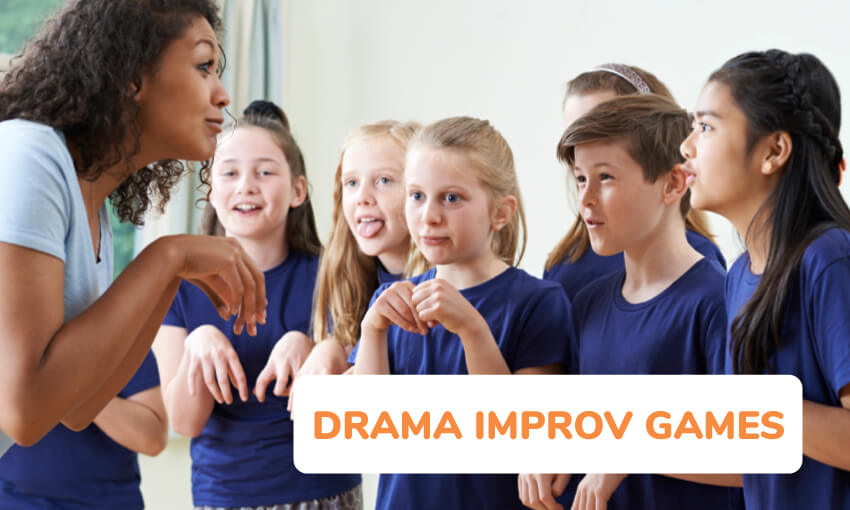Looking for some fun improv games for kids? Look no further. Here you will find an extensive list of improv activities that will lead to hours of fun and laughter.
Improv is a great way to boost social skills, teamwork, and critical thinking.
The first thing to teach the participating group is the word Chivalry.
In improv, Chivalry means not clinging to your own ideas, your own status, or personality as a character.
Chivalry is daring to give up control. Players should allow themselves to be changed by other players. They should be happy to change; change in improv is a good thing!
1. WHAT HAPPENED NEXT IMPROV EXERCISE
One player is in the middle, the others sit aside. Any person can give the middle player a task, which she performs, and then she asks, `What happens next?’
Any player may suggest what needs to happen next, but the idea is for the group to construct a coherent story.
The player in the middle should only and strictly be doing what they’re told; it is up to the players at the side to construct the story. This game is also known as And Then.
2. YES! LET’S ______! IMPROV WARM-UP
This is a great drama practice and a great introduction to Accepting.
Pick a group activity, such as throwing a party or organizing a picnic.
One player starts, saying, “Let’s ______,” filling in what they want to do. Then, they actually start doing what they said they wanted to do.
A second player jumps in, saying, “Let’s________.” (It’s doing something else– to advance the group activity.) Both players say, “Yes, let’s do that,” and start doing whatever was suggested.
The third player jumps in and suggests what to do, and again, all the players loudly agree to do it and actually do it. Continue till everyone has suggested something.
3. ENERGY 1-10 IMPROV ACTIVITY
Everyone is positioned in a big circle, squatting down. All participants count 1 to 10. This is done in unison – moving up slowly with increasing energy level.
1 is barely audible, 10 is as loud as possible – with everyone standing straight, hands reaching up.
It’s important to watch each other, to ensure all are at the same energy level. Also, make sure that the increase in energy is very gradual.
4. ALIEN, COW, AND TIGER
( To prevent confusion, write directions for characters on a whiteboard. )
Everyone is in a circle. There are 3 things a player can be:
- An Alien: hold your index fingers up next to your head, as little antennae and say `Bleeb bleeb,` bending inwards into the circle.
- A Cow: bend forward, hold your right hand on your tummy and go `Moooo.`
- A Tiger: push your right hand forward, imitating a claw and roar.
On your signal, each player becomes one of the three. The idea is for everyone to become the same, which obviously won’t be the case the first time. Re-do this until everyone is in sync.
5. POPCORN
Everyone finds themselves a spot and squats down. The facilitator talks the group through the exercise.
“Everyone is a piece of corn, the floor is a big pan, and we’re going to make popcorn. We slowly start heating the pan.”
As the pan gets hotter, the corn starts to `pop.` A player `pops` by jumping up, clapping hands above their head, and saying `pop.` Make sure the `popping` starts gradually, `popping` is a group thing, and in the end, `popping` should stop.
Variation: Forget to take the pan off the fireplace and have the popcorn start burning.
6. ONE WORD AT A TIME STORY
This is an exercise to train a group narrative. All players sit in a circle. A story is told one word at a time.
Each player provides one word of a sentence. The end of a sentence can be indicated by a player saying `period` although that is unnecessary.
This is more difficult than it sounds, especially with newbies. If you’re working with novice players, have them try a familiar story, such as Snow White & the Seven Dwarfs.
Summarize the story before they get started, to make sure they’re all on the same story. Don’t be surprised if gagsters smuggle atomic bombs and crashing aircraft into the story.
If so, ask the group if they can see/understand the reasons their story isn’t as it could be. If the group is large, divide it into 2 or more story circles.
7. RUMORS

Form a circle with improv participants. One person starts by saying, “Did you hear about _____?” and then points to someone else in the group.
That player immediately replies with the answer to the fill in blank., after which everyone gasps or giggles.
The person left of the second person restarts. The blanks can be anything: something as simple as soup, or something as convoluted as the white bear that ate a Russian kid for lunch in Novosibirsk last Thursday.
8. ACCEPTING CIRCLE
Put everyone in a big circle. One player starts by making a little gesture, perhaps with a little sound.
His or her neighbor then tries to do exactly the same. This continues around the circle. Although we expect the gesture/sound not to change, it will!
Watch for movements that suddenly change a left/right arm or leg. This is not supposed to happen, but it will. Once happened, it should be accepted by the next player.
Also, watch/listen for little moans or sighs that players might make before or after their turn – these should also be taken over by the next player.
9. EMOTIONAL MIRROR
Players are in pairs, facing each other. One talks in gibberish, with a specific emotion (angry, happy, in love, your choice).
The other instantly copies the emotion of the first player and speaks in his own gibberish. There is no need to try and copy the other player’s gibberish; both players keep talking – no pausing allowed.
After about 10 seconds, the second player changes emotion, and the first one immediately follows.
10. PEOPLE PICTURE

Range: 9+ (Number of Participants: 2-20)
Materials: Pictures of people, as many as participants. See Notes.
Participants will use pictures as inspiration in creating characters and interact with others as their characters.
They will try to determine which picture the other participants used for their inspiration after interacting with them.
How to Play:
Participants spread themselves out in the room so each person has enough space to think without distractions.
The leader passes out a picture to each participant, explaining, “DO NOT let anyone else, even me, see your picture. You have three minutes to look at the person in your picture and become that person.
Decide what kind of personality he or she has, how old the person is, what kind of life they lead, etc. Use the picture to help you decide – are there details about the person’s clothes, their surroundings, and their face which give you ideas?
Try to create a “story” for this person, and a voice, mannerisms, attitude.
All of your characters will attend a party at the end of the three minutes.” The participants should not talk to one another before the three minutes are up.
At the end of the three minutes, the participants hand in their pictures. As soon as they hand in the picture, they transform into their character.
The leader should explain that they need to talk to the other characters, as if they are at a party. The participants should attempt to talk to everyone else and try to remember things about the other characters.
The party lasts five to ten minutes, depending on the number of participants.
At the end of this time, the leader asks everyone to discard their characters and become themselves.
The leader then shows the participants the pictures that were used and asks the group to identify whose character matches with the picture. Don’t tell the participants that this will happen ahead of time.
The temptation of “fooling” everyone is too great to resist for some people, and these people will purposefully make their character unlike their picture if they know there will be guessing.
The group should discuss their reactions to their pictures and to others’ and how everyone developed their character.
Notes:
The pictures can be cut out of magazines, and then pasted onto oak tag or poster board for stability.
Try to get a good assortment of pictures of people – all ages, races, levels of attractiveness; don’t put any famous faces in the selection.
The more interesting the setting and the appearance of the person, the more there is for the participants to use for inspiration.
Remember, there are no wrong answers – but the participants should be able to answer “why” questions about the character and picture.
11. CROSS THE CIRCLE IMPROV GAME
Everyone is numbered around the circle as 1, 2, OR 3. The leader calls a number such as 2. All number 2s must cross the circle in one role of leader’s choice as:
- A ballerina
- A panther
- A moonwalker
- Someone who’s stuck in the mud
- A fashion model
- Whatever your imagination comes up with!
After all the number 2s cross the circle, a different number is called; they are told to cross the circle in the manner the lead directs.
12. CROSS DIFFERENTLY

Name a child to cross the circle to an empty chair in any way they like, walk, crawl, hop, twirl, whatever. They call someone else who must cross in a different way.
13. ANIMAL SCENES
Players find a partner; partners separate and run around. The leader calls out a phrase and the players must find their partner and depict the scene. The last pair to depict the scene is out.
Examples:
- Frog on a log: One student gets down on all fours (log) and the frog sits gently on their back.
- Bird on a perch: One student gets down on one knee (perch) and the bird sits on the perch.
- Lion in a den: One person stands with their feet apart (den) and the lion lies down on the floor.
14. Count your words
Great twist on a basic improv game. Every person that plays gets a random number between 1 and 10.
And the number that is assigned to you is the number of words you are allowed to speak when it’s your turn.
For example if you got the number 2, when it’s you turn to improv, you can only speak 2 words.
Last man to survive, wins the round.
15. Sound Effects game

A great game to stretch your imagination.
Ideally played by 4 people that are divided into 2 teams of 2 players each. One team is the announcers and their mission is to improv a story line while the other two needs to make the sound effects on the fly.
If you think you won’t burst into laughter during this one, think again.
16. Lines from a hat
Yes, just like the famous game from the popular and very old TV show ” Who’s line is it anyway ” this game is called lines from a hat.
Write down at least 10 scene ideas on pieces of paper and put them all inside a hat. Now each player needs to reach inside and get one without looking.
Whatever scene is written on the note, that’s what you need to act out, no matter how weird or hilarious it is.
17. Questions only
As the name implies, this simple game only has one rule, you must communicate with questions only. You can’t speak if it’s not in a form of a question.
You might think it’s easy enough, but trust us, it’s very hard after the first sentence is spoken.
18. Party characters

This is a fun game, usually played by at least 3 people, but 4 would be better.
The game play is that one of the players is acting as the host of the party, while the other players has to decide on a specific character they act out without telling the host.
One by one they ring the door bell and enter the party with their odd character while the host needs to guess each character within a time limit.
A few great examples of characters are:
- An angry cab driver
- Retired athlete that can’t get over his career
- Person who thinks he is in space
Feel free to make your own up.
19. Space Jump
A group of people is needed for this game. One player starts a scene and once the group shouts ” Space Jump ” the player must freeze in place and the next player jumps in to keep the scene alive from where the first froze.
20. Unlikely Superhero
A hilarious game that’s actually our favorite from this list. Take a group of kids or people and suggest a world emergency situation, for example: an astroid is falling to earth threatening to destroy us.
Now suggest together with that an unlikely super hero that has special powers that are weird, and the first player needs to go on stage and act the scene but ultimately fail and calling on the next super her after him that continues the same.
21. Job interview

A fun game to get the little ones ready for the real world ( kinda )
Place a chair in the middle of the room, and pick the kid that will be the interviewee.
Ask him to leave the room for a second while the group decides on a job he needs to interview for. When you decide call him back in and have him act a job interview and answering questions while having no idea to what position he is applying to.
Some great job ideas:
| Dog Walker for the super rich | Tour bus driver |
| Pro basketball player | Pilot |
| Walmart baby seller | Software developer |
22. The location game
A game to play with an audience or just divide the group into two. The acting group needs to decide on a few places, like the beach, traveling the safari or going to Disneyland.
Once they decide they need to act the scene as if they were in that place but they can’t speak. The other group needs to guess the location.
23. Expert group
A group of kids is given a question that needs a solution, for example ” How to improve my physical shape ” and they all have to act as one person and collaborate to offer solutions.
24. Prop game

This one I like, you take toys or just stuff around the house, or around the class if you are in school. and you put it in a box.
Now every kid needs to pull up an item and improv a scene or frame using that item. It makes for funny situations and excellent improv challenge.
25. Heads down
A group of kids standing in a circle and putting their heads down, once the leader yells ” heads up ” everyone should look up but NOT look at each other.
If someone looks at someone else, he is eliminated from the game. The game continues until no one is left.
26. What animal am I
Easy game to play, every kid needs to think about an animal he would like to act out. Each in his turn needs to act the scene without speaking and let the group guess what animal he is acting out.
EIGHT RULES WHEN DOING IMPROV
- Don’t negate or deny the other player – follow where they’re going
- Don’t ask questions
- Make choices based on actions
- Do make assumptions
- Do give and take
- Listen, watch, and concentrate
- Work to the top of your intelligence
Drama Menu Links
- The Different Types of Drama
- Pantomine, Tips and Games
- Improv Games and Exercises
- A Variety of Drama Games/Activities
- Costumes and Makeup
- 301 Trivia Questions for Kids




